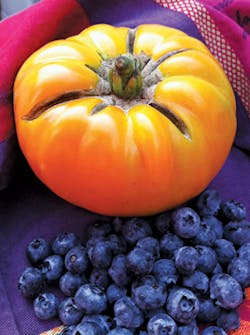LIGHT-EMITTING DIODES/FOOD PROCESSING: Monochromatic light found to enhance fruit flavors, flower scents
Specific wavelengths of light can affect volatile compounds that control aroma and taste in such high-value crops as tomato, blueberry, strawberry, and petunia. So say the results of a new study by researchers at the University of Florida (UF, Gainesville). The upshot, says assistant professor Thomas Colquhoun, is that light may enable improvement of the flavor and nutritional content of fruits, vegetables, and herbs; and the scent of flowers.1
The team began by exposing petunia cuttings to narrow-bandwidth LED light of various wavelengths. They found that 2-phenylethanol, a key floral volatile, increased when the plant was exposed to red and far-red light. Similar tests on tomato, strawberry, and blueberry showed that flavor volatiles in each one could be manipulated to varying degrees.
The technology could be used by businesses involved in post-harvest handling and shipping—grocery stores, greenhouses, and food processors—said Kevin Folta, chairman of UF's horticultural sciences department. He added that consumers might also use it in their homes: Instead of a light shutting off when you close your refrigerator door, a light could turn on when the door closes.
The team is now working with UF dentistry professor and taste expert Linda Bartoshuk on a National Institutes of Health-funded study that will test whether consumers can taste differences in light-treated fruit. The approach could hold vast potential for plants used for both food and medicine.
1. T. A. Colquhoun et al., Postharvest Biol. Technol., 86, 37–44 (2013).
